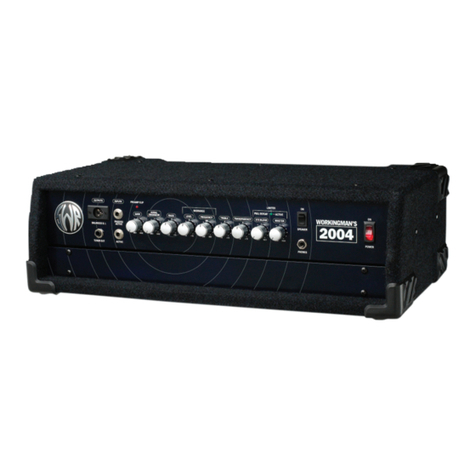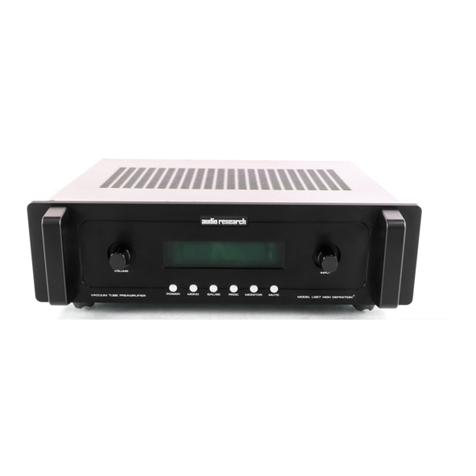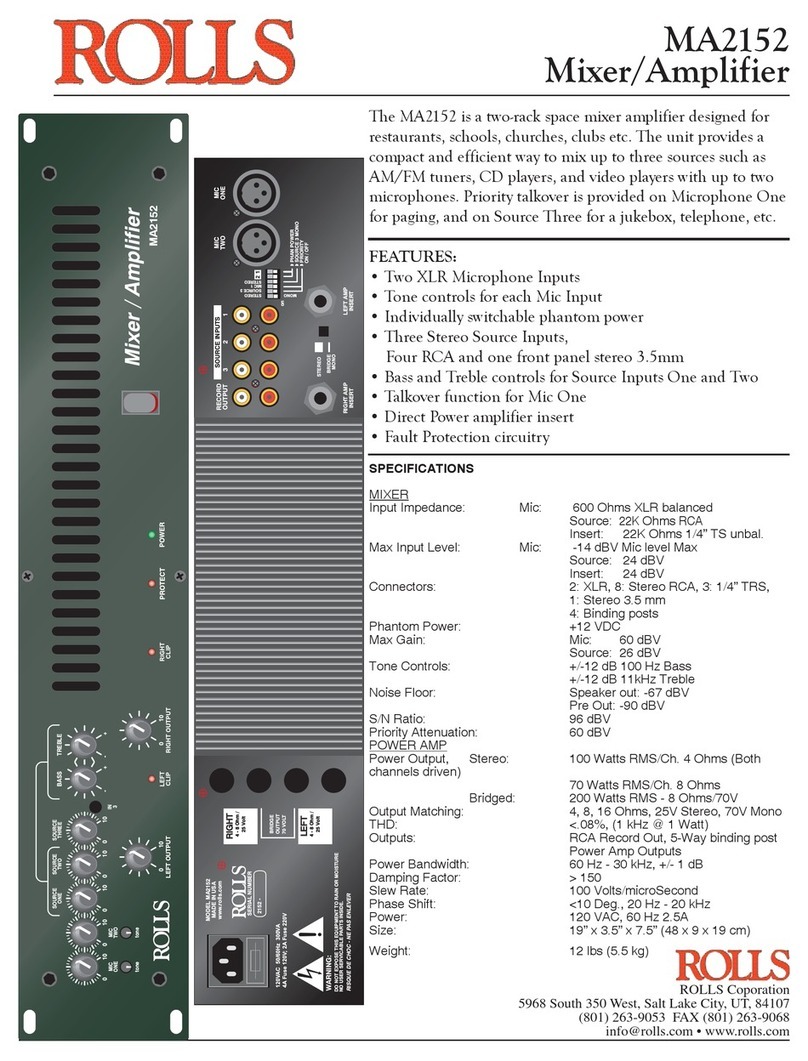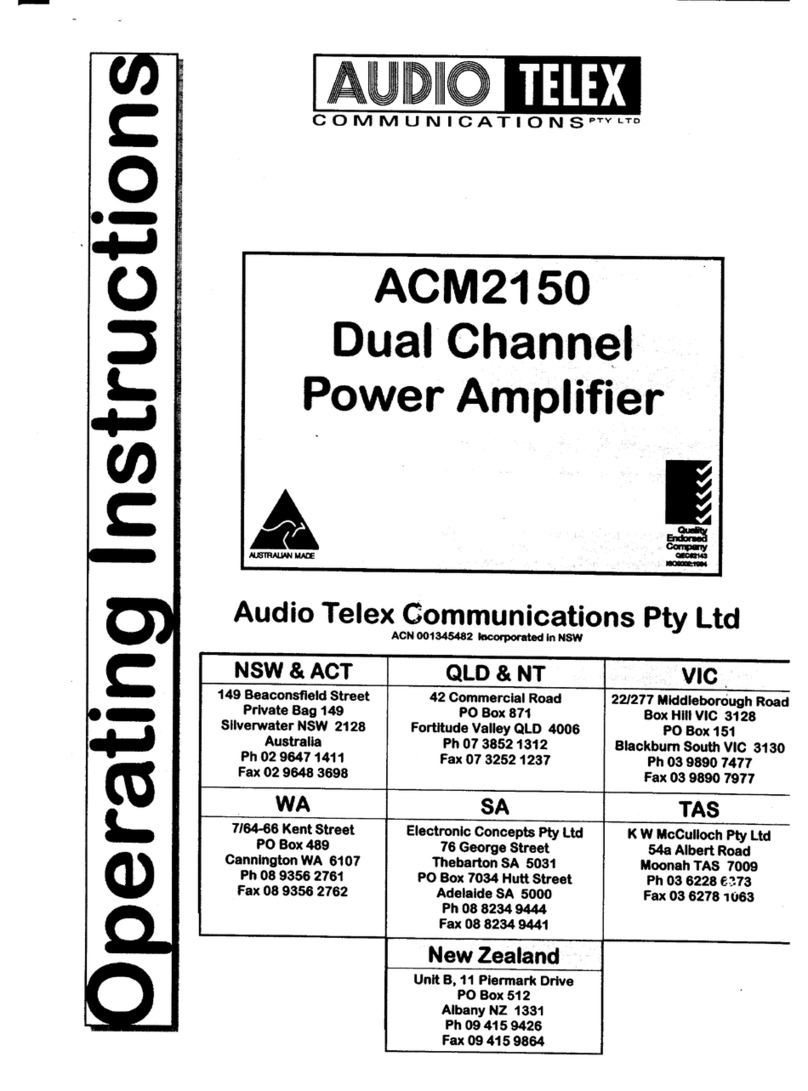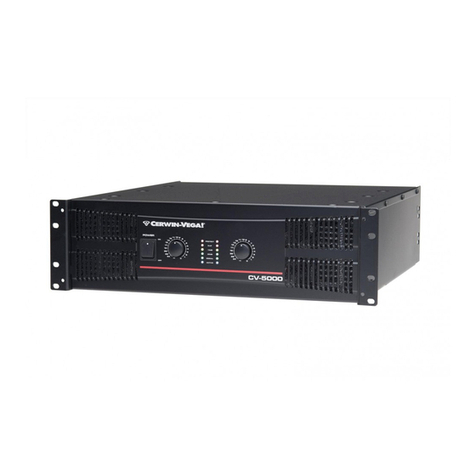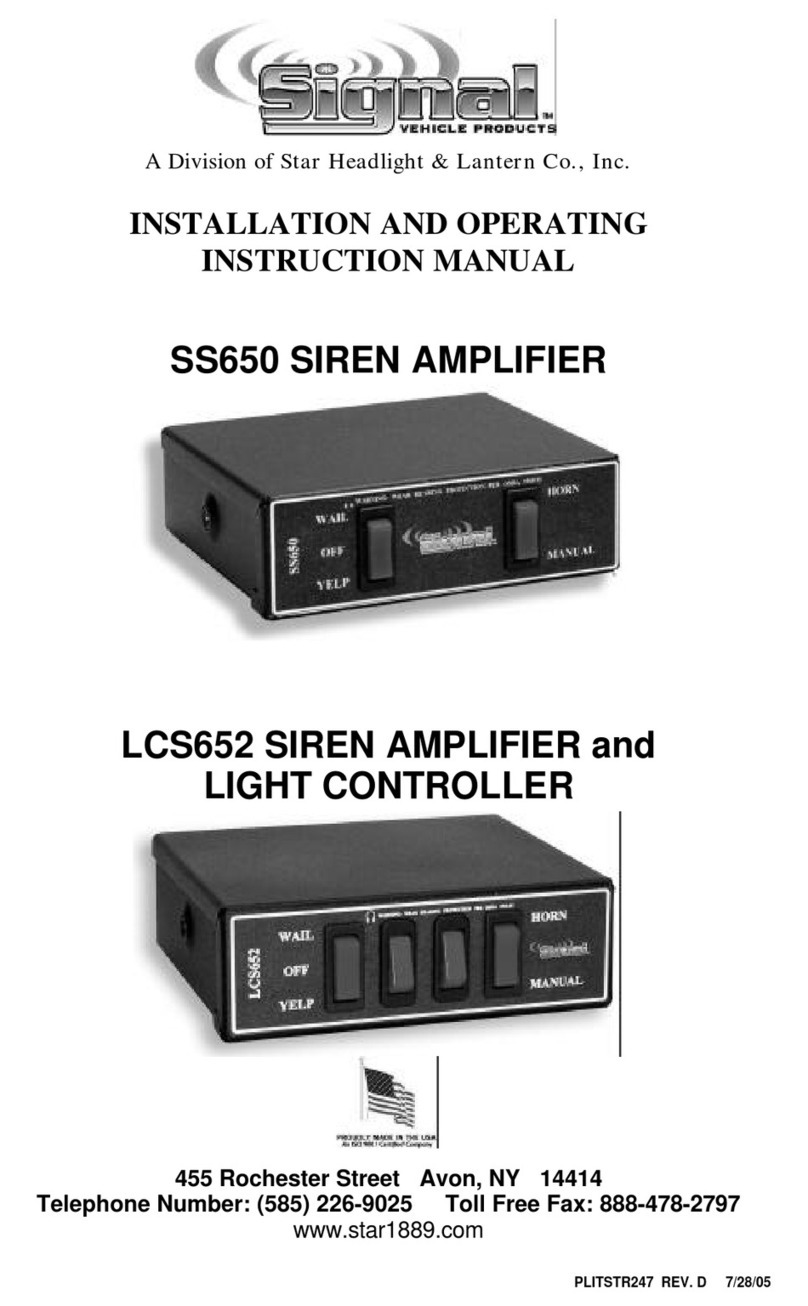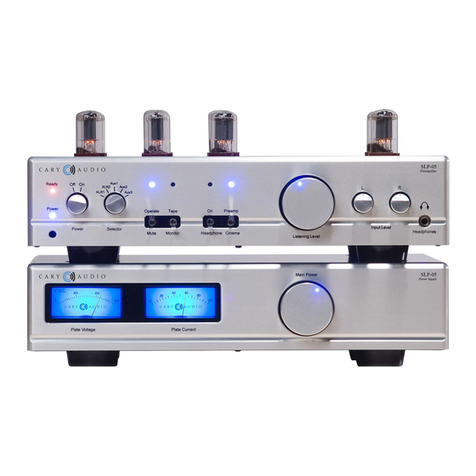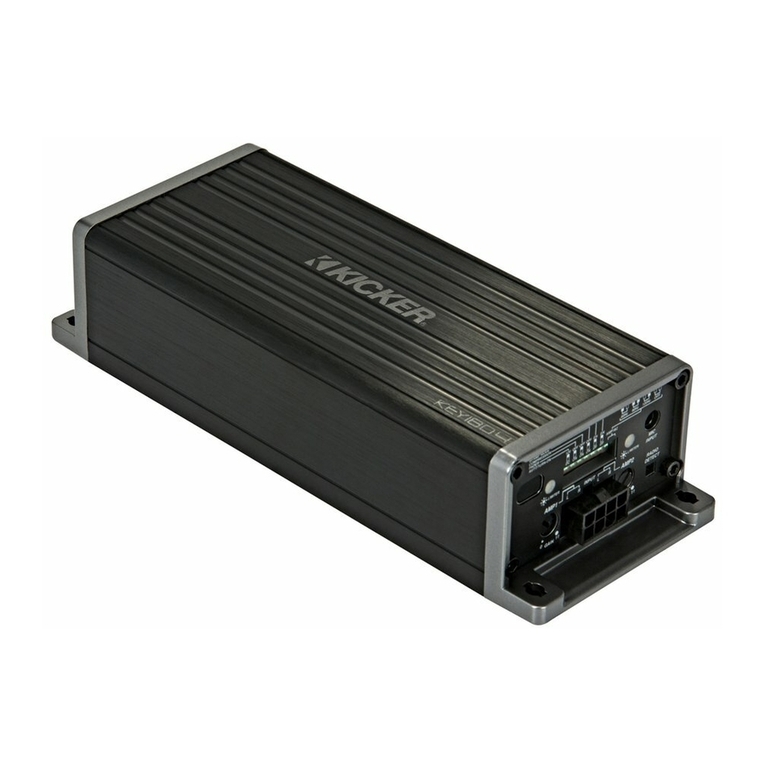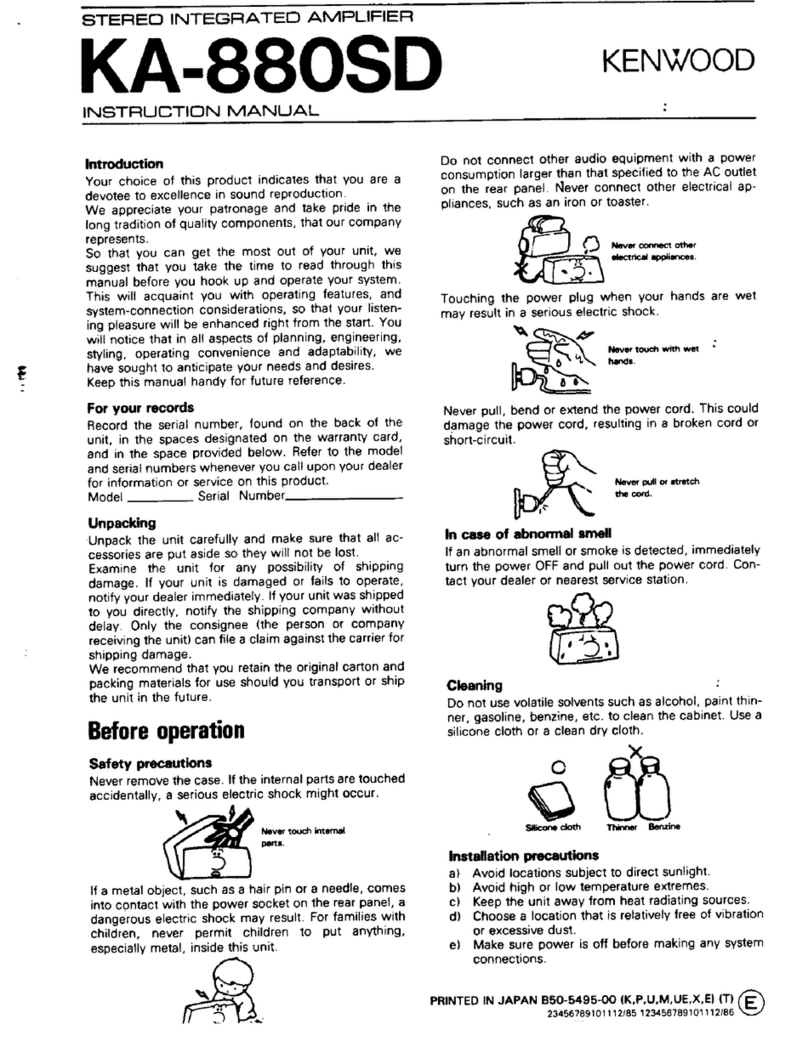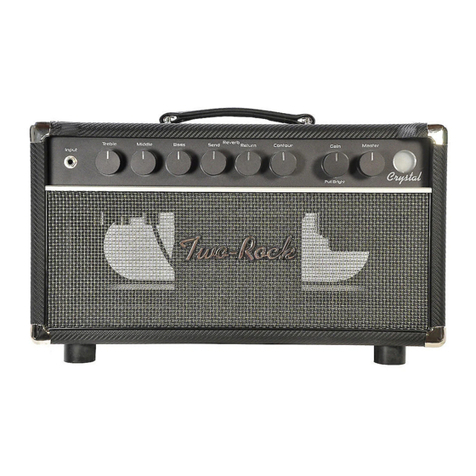SWR Strawberry Blonde User manual

Strawberry
Blonde
OWNER’S MANUAL
SWR • CORONA, CA • USA

IMPORTANT SAFETY INSTRUCTIONS
CAUTION: TO REDUCE RISK OF ELECTRIC SHOCK, DO NOT REMOVE THE COVER OR BACK. NO USER-SERVICE-
ABLE PARTS INSIDE. PLEASE REFER TO A QUALIFIED SERVICE TECHNICIAN.
A. Read Instructions: All safety and operation instructions should be read before the product is operated.
B. Retain Instructions: The safety and operating instructions should be retained for future reference.
C. Heed Warnings: All of the warnings on this product and in the operating instructions should be adhered to.
D. Follow Instructions: All operating and use instructions should be followed.
E. Cleaning: Unplug this product from the wall outlet before cleaning. Do not use liquid cleaners or aerosol cleaners. Use a slightly damp cloth for cleaning.
F. Water and Moisture: Do not use this product near water; for example, near a swimming pool, wet basement, and the like.
G. Accessories: Do not place this product on an unstable cart, stand, tripod, bracket or table. The product may fall, causing serious in ury to a child or adult, and
serious damage to the product.
H. Ventilation: Slots and openings in the unit are provided for ventilation and to ensure reliable operation of the product, to protect it from overheating, thus these
openings must not be blocked or covered. This product should not be placed in a built-in installation such as a bookcase or rack unless proper ventilation is provided or
the manufacturer's instructions have been adhered to.
I. Grounding: This product is equipped with a three-wire grounding-type plug, a plug having a third (grounding) pin. This plug will only fit into a grounding-type power
outlet. This is a safety feature. If you are unable to insert the plug into the outlet, contact your electrician to replace your obsolete outlet. Do not defeat the safety pur-
pose of the grounding-type plug.
J. Power Cord Protection: Power supply cords should be routed so that they are not likely to be walked on or pinched by items placed upon them, paying par-
ticular attention to cords at plugs and the point where they exit the product.
K. Lightning: For added protection of this product during a lightning storm or when it is left unattended and unused for long periods of time, unplug it from the wall
outlet. This will prevent damage to the product due to lightning and power-line surges.
L. Overloading: Do not overload wall outlets or extension cords as this can result in a risk of fire or electric shock.
M. Object and Liquid Entry: Never push ob ects of any kind into this product through the openings as they may touch dangerous voltage points or short out
parts that could result in a fire or electric shock. Never spill liquid of any kind on the product.
N. Servicing: Do not attempt to service this product yourself as opening or removing covers may expose you to dangerous voltage or other hazards. Refer all ser-
vicing to qualified service personnel.
O. Damage Requiring Service: Unplug this product from the wall outlet and refer servicing to qualified service personnel under the following conditions:
1) When the power supply cord has been damaged
2) If liquid has been spilled or ob ects have fallen into the product
3) If the product has been exposed to rain, water, or other conductive liquids
4) If the product does not operate normally by following the operating instructions
5) If the product has been dropped or damaged in any way
6) When the product exhibits a distinct change in performance.
P. Replacement Parts: When replacement parts are required, be sure the service technician has used replacement parts specified by the manufacturer or have
the same characteristics as the original part. Unauthorized substitutions may result in fire, electric shock, or other hazards.
Q. Safety Check: Upon completion of any service or repairs to this product, ask the service technician to perform safety checks to determine that the product is
in proper operating condition.
R. Heat: The product should be situated away from heat sources such as radiators, heat registers, stoves or other products that produce heat.

STRAWBERRY BLONDE OWNER’S MANUAL • 1
INTRODUCTION
The Strawberry Blonde, a smaller version of its big sister the California Blonde, is a single channel, 80 watt combo that produces a warm,
dynamic tone full of crisp acoustic flavor.
Equipped with both a custom designed 10-inch SWR speaker and a piezo tweeter, the Strawberry Blonde compliments all types of
acoustic instruments including violin, cello, acoustic bass, mandolin and guitar.
FEATURES INCLUDE:
• Gain Control
• Aural Enhancer
• Bass Control
• Midrange Control
• Treble Control
• Spring Reverb
• Discrete Solid-State front end
• Master Volume Control
• Side Chain Effects Loops
• Balanced XLR Line Output
• Headphone Jack
• Extension Speaker Jack
• Top Strap Handle
• Bottom Slot Port
• Blonde Tolex Covering
• Chrome Protective Corners
• Vibration-Free Speaker Grill
SPECIFICATIONS
Speaker Compliment: (1) Custom SWR 10" speaker, (1) Le-Son TLX-1 Piezo Tweeter
Power Output: 80 Watts RMS
Enclosure Impedance: 8 Ohms
Dimensions: 18.5"H x 16"W x 13.75"D
Weight:40 lbs.
FRONT PANEL FEATURES
INPUT
The instrument input accepts a 1/4" mono phone plug. The input “senses” either a magnetic or piezo pickup, therefore separate inputs or
a selector switch is not needed (as on other acoustic amplifiers). If you hear any distortion when using this input, make sure to check the
battery in your instrument.
GAIN CONTROL
Proper use of this feature will ensure maximum signal to noise ratio (quiet operation) and prevent unwanted clipping (distortion) in the pre-
amp section. The following procedure should be followed.
1. Turn the Master Volume to the “MIN” position. Plug your instrument into the input ack. The volume control on your instrument
should be set at maximum (because we all know sooner or later it will get there during the night!). Start with the Strawberry Blonde’s tone
controls set to the “0” (flat) position and the Aural Enhancer in the 12 o’clock position.

2. Starting from “MIN,” raise the Gain control while striking your loudest chord or note. If you begin to hear distortion, back off the
Gain control until the distortion is no longer present.
3. Use the Master Volume to set the overall desired loudness.
The Aural Enhancer and tone controls can have an affect on the optimal setting of the Gain control. After you have set these to your liking,
repeat steps 1 through 3.
To accommodate a wide range and variety of instruments and mics, the Gain control’s taper or action was designed to start slowly. This
allows a better finite position to achieve the proper Gain setting for your instrument. In other words, you may notice that the volume
changes more rapidly after the Gain Control reaches about the 11 o’clock position. This is normal and was done for the reason stated
above.
The Gain control also “drives” the effects send signal and internal reverb circuitry. Effects units used in the effects loops should be able to
accept line level signals. If your effect is being overdriven at the input, you can turn down the Gain to alleviate this condition. Reset your
Master Volume for desired overall volume.
AURAL ENHANCER
SWR’s Aural Enhancer Control was developed to bring out the fundamental low notes of all instruments, reduce certain frequencies that
help mask the fundamentals, and enhance the high end transients. Basically a tone shaping control, the Aural Enhancer is a passive R/C
network that alters the frequency response throughout the frequency spectrum. This pre-shaping is “blended” into the original signal via
the Aural Enhancer Control. Exact frequencies affected are dependent on the characteristics of the instrument used.
TONE CONTROL SECTION
The Strawberry Blonde’s Tone Control section is a three-band set of level controls centered around the frequencies 80 Hz (Bass), 800 Hz
(Mid Range) and 5kHz (Treble). Each control can cut or boost its band a maximum of 15dB. Each control has a flat (center click) position
that defeats its function. In this position, the tone controls are inactive. For each tone control, rotating the knob counter-clockwise from
the center click position will reduce or cut its designated frequency. Rotating the knob clockwise will boost its designated band or fre-
quency.
USING THE TONE CONTROLS
To get the most out of the Tone Controls of your Strawberry Blonde, it would be best to first understand how the Aural Enhancer works,
and how it interacts with the Bass, Mid Range and Treble controls. Think of it as a variable tone curve, changing with its position. As you
raise the control from its “0,” or fully counterclockwise position, you are elevating the whole range of sound (lows, mids, and highs) at fre-
quency points different than those selected for the individual Tone Controls.
This remains true up to about the “2 o’clock” position, at which point selected mids start to drop off. The curves involved here are gentle,
as opposed to the very extreme curves you can create with the Tone Controls. Most significantly for basses, the Enhancer will help bring
out the fundamentals of your lower registers without masking them with overtones, such as the Bass control. At the same time, it opens
up the sibilance characteristics of all instruments without being harsh.
Most players prefer setting the Aural Enhancer between 10 and 2 o’clock. Try playing a chord and move the Aural Enhancer from one
extreme to the other. You should find a setting that is pleasing to your ear.
The Bass control works in a range that will be useful under most “normal” conditions. Its musical use might be thought of as a “fatness”
control. The overall “punch” of your instrument will be determined with this control. With passive instruments, this will be straightforward.
With active instruments having bass-boost/cut functions, more exploration will be worthwhile.
The Mid Range control operates in a crucial area for most instruments. Many basses, particularly those strung with roundwound strings,
and some pickups for acoustic instruments, can have a very “honky” or nasal sound. Dropping the Mid Range control can go a long way
toward smoothing out your tone. We suggest, though, that what sounds best when your listening to your tone by yourself may not be what
works best in a band or recording. Sometimes that ob ectionable quality may be ust the right “hair” on your note to still have an audible
presence in the track or on stage.
The Treble control operates in a tonal area that extends through and beyond the usual Treble control range. It may be thought of as a
“transparency” control. Over time, we have found this approach to result in a more musically useful treble. Boosting the the control will
open up the sound of a dull instrument, particularly in con unction with the piezo tweeter in the Strawberry Blonde’s speaker complement.
However, this is also the range of string rattle, finger slides, pickup clicks, etc. Again, we recommend you experiment with the control
2• STRAWBERRY BLONDE OWNER’S MANUAL

STRAWBERRY BLONDE OWNER’S MANUAL • 3
alone with your instrument while finding your tone, and listen again in a band context, both near to and away from the Strawberry Blonde.
Qualities like punch, fatness, presence and bite can be fairly well spread out. Treble, despite the broad dispersion of the piezo tweeter, is
a very directional quality. Spend some time exploring what you can hear in this area as you move around.
EFFECTS BLEND
The effects loop circuitry in the Strawberry Blonde is a “side chain” design, the same concept as used in studio mixers or consoles. The
Effects Blend control mixes the signal coming from your instrument with the sound coming from your effect. With the Blend control fully
counter-clockwise, no signal from your effect will be heard. As you turn this control clockwise, more of the effect can be heard in the over-
all sound. When the Blend is fully clockwise, no dry or unaffected signal is heard other than the output of your effects device.
This type of control and patching arrangement is very effective in reducing noise caused by effects units and in maintaining a more natur-
al sound. If your effects device has a similar control, we suggest leaving it set to its maximum effect/minimum dry signal position and
using the Effects Blend control for this function. Please read the “Effects Loop” section for more information.
REVERB CONTROL
The Reverb control blends signal from the internal spring reverb with the main signal. The reverb circuitry is on a side chain as well, so the
natural sound of your instrument is always maintained. Rotating this control clockwise will add more reverb to the overall sound.
MASTER VOLUME
The Master Volume ad usts the signal level going to the power amplifier, Stereo Headphones ack, extension speaker and the internal
speaker system. It does NOT affect the Balanced XLR Line out. For optimum signal to noise ratio, it should be used in con unction with the
Gain control. Losses caused by effects units can be recovered by increasing the Master Volume.
STEREO HEADPHONES JACK
By inserting a set of stereo headphones into this ack you will be able to monitor your sound or practice without disturbing your neigh-
bors. The volume level is ad usted by the Master Volume. We suggest you begin with the Master Volume off (fully counter-clockwise), then
slowly bring the volume up to your desired level. If you hear distortion in your headphones that is not present with the speakers on, turn
down the volume as you are probably overdriving your headphones and could cause them damage.
To practice silently, position the 3-way selector switch on the back panel to the “Head Phones” (middle) position. Any impedance stereo
headphones will work. However, optimum impedance is 75 ohms. Do NOT use mono headphones as they will short out one channel.
3-WAY SPEAKER PHASE SWITCH
This switch serves two purposes. First, it sets the phase position of the speaker output. Second, it can act as a speaker mute for silent
practicing or tuning.
When the switch is set to the IN (up) position, the output (speaker) is in phase with the input. In the OUT (down) position, the reverse is true.
The purpose of this feature is too inhibit regenerative feedback. This method is superior to a notch filter as it does not alter the overall
tone. If your instrument starts to feedback, set the switch down to the OUT position to reverse the phase. It should be noted however, that
the distance between you and the cabinet is a factor. Depending on your proximity to the cabinet, changing the phase could actually
cause an increase in feedback.
Most feedback in acoustic instruments occurs in the lower registers. If ample volume is not obtained through use of the phase switch or
changing your position in relationship to the amp, try putting the Strawberry Blonde on a chair or stand off the floor.
The middle position, labeled HEADPHONES, disconnects the signal going to the internal speakers and extension speaker ack. Use this
position when listening through headphones only or for silent tuning (refer to "Tuner Send" section). The Headphones ack is always active
regardless of the position of this switch.
POWER SWITCH
Pressing the Power switch to the “On” position activates the Strawberry Blonde’s electronics as indicated by the green LED above the
switch. A slight pop will occur when the unit is first turned on. This is normal and will not harm any of the components in your amp or
speaker cabinet.

REAR PANEL FEATURES
TUNER SEND
This feature allows the user to connect their instrument tuner to the Strawberry Blonde without having to unplug and go back and forth
from amp to tuner to amp. The Tuner send is isolated from the rest of the circuitry and no other controls other than your instrument affect
the signal. Being on a side chain (isolated) also avoids loading down of the instrument which can cause a loss in dynamic range. To use
the Tuner send, connect a shielded patch cable from this ack to the INPUT of your tuning device. Turn the amp on and you're ready to go.
If you don't want to monitor your sound while tuning, turn down either the Gain or Master Volume or position the selector switch on the
back panel to the “Head Phones” position.
EFFECTS LOOP
The Strawberry Blonde’s Effects Loop is located POST EQ and PRE Reverb & Master Volume in the signal path. The level appearing at the
Send acks is controlled by the Gain functions on the front panel. If you are getting too hot a signal at the input of your effects unit, reduce
the level of the Gain control. You can raise your Master Volume to retain similar overall volume levels. By using the Gain, Master Volume
and Effects Blend controls, optimum performance should be easily obtainable with any effects device.
Because the Effects Loop is on a side chain, it should greatly reduce noise generated by effects devices (as compared to in-line effects
loops). Additional features of this type of loop can be found below under the Receive ack section.
SEND JACK
Run a shielded patch cable from the Send ack to the input of your effects device. This ack may be used as an additional line level output,
in which case its level is determined by the setting of the Gain control.
RECEIVE JACK
Run a shielded patch cable from the output of your effects device to the Receive ack.
One unique feature of the Receive ack is the ability to practice along with pre-recorded music. Insert a sound source into the Receive ack
(make sure it’s a mono signal). Use the Effects Blend control to mix the level of the recorded music with your instrument's level. The com-
bined signal will be heard through the internal speakers or your headphones. The Send ack is not used.
NOTE: Inserting a plug into the Receive ack activates the Effects Blend control by receiving a “command” through the ground
created. Therefore, only a mono (2-conductor) phone plug should be used.
If you are not getting any “effect” through the speakers, check the position of the Effects Blend control on the front panel.
BALANCED LINE XLR OUT
Being a "line" out, the signal appearing here is similar to that heard through the speaker system. All of the controls on the front panel,
except the Master Volume, will affect the sound.
To use this feature, run an XLR cable from the Balanced Line out to the input of a mixing console, tape machine, etc. This output is also suit-
able for sending a signal to a house mixer in live situations.
Wiring for the XLR connector is American standard: Pin 1= ground, Pin 2= +, Pin 3= –
3-WAY TWEETER MODE SWITCH
This switch gives you three different options for operation of the piezo tweeter. In the ON (left) position, the tweeter will reproduce a full
range, unattenuated signal of every frequency it sees (roughly 2 kHz up to 15 kHz, within certain tolerances). The -6db (right) position
reduces the level of the tweeter's outputs by 6 decibels, which to the ear sounds roughly as if cut in half compared to the Full Range posi-
tion. The OFF (middle) position will defeat the tweeter's output entirely.
Try starting with the switch in the Full Range position. If this sounds too "treble-y" to your ear and you still want the touch of crispness
that a tweeter provides, you can: a) set the Tweeter Mode Switch to -6db; b) ad ust the Treble tone control on the front panel; c) a combi-
nation of both.
NOTE: We have found that most fiddle and violin players prefer the tweeter out of the circuit (Horn Off position). This can be true for
some upright bass and cello players as well. Guitar, Dobro, bass and mandolin players tend to like the horn activated. Try it both ways and
pick the setting that sounds best to you. The Treble control's range is very similar to the response of the tweeter and can be used as a
"high end pad."
4• STRAWBERRY BLONDE OWNER’S MANUAL

STRAWBERRY BLONDE OWNER’S MANUAL • 5
EXTENSION SPEAKER JACK
Use an unshielded 2-conductor cable (NOT A GUITAR CORD!) to connect an additional speaker cabinet. Use a high quality, heavy gauge
cable of at least 18 gauge (the lower the gauge, the heavier the cable). The impedance of the extension speaker should be 8 ohms or
greater. If you wish to connect two additional cabinets be sure their combined load impedance is not less than 8 ohms (equivalent to two
16 ohm speaker cabinets in parallel).
A/C LINE (MAINS) FUSE
The line fuse can open (blow) due to power surges or high power line transients. This fuse will also open in the unlikely event of an elec-
tronics failure inside your amplifier.
Correct size and rating of the line fuse: 3AG, 2 amp slo-blow for 120V operation. 3AG, 1 amp slo-blow for 240V operation. Do not defeat
the purpose of this fuse by using a higher amperage rating. This could void your warranty.
A/C LINE CORD RECEPTACLE
Accepts a standard A/C power cable (supplied with the Strawberry Blonde in the United States), used with almost all current musical, pro-
fessional and household electronic devices. If it becomes misplaced, replacements can be found at almost any computer, electronics, or
pro audio store. Please note: the rating for this cable is 3-conductor, 18 gauge, 10 amperes. If replacement is necessary, or if you wish to
buy a longer cable, look for the correct rating on the cable.
CABINET FEATURES AND INFORMATION
SPEAKERS
(1) 10" stamped frame woofer, 100 watts, 8 ohm impedance; (1) high frequency piezo tweeter, 150 watts (4kHz and above), 8 ohms.
Crossover point fixed at 4kHz. Frequency response: 30Hz to 16kHz.
CABINET
Made from a combination of plywood and particle board. Interlocking dado and rabbet oints, glued and nailed. Covered in a "sandstone"
vinyl covering. Metal corners. Comes with our “Texas Bar Proof” powdercoated speaker grill. Front slot port located at bottom.

STRAWBERRY BLONDE LIMITED WARRANTY
The STRAWBERRY BLONDE from SWR is warranted to the original consumer purchaser for ONE
YEAR from the date of purchase against defects in materials and workmanship, provided that it is
purchased from an Authorized SWR dealer. This warranty applies only to products purchased in
the USA or Canada.
This warranty is VOID if the unit has been damaged due to accident, improper handling, installa-
tion or operation, shipping damage, abuse or misuse, unauthorized repair or attempted repair, or if
the serial number has been defaced or removed. FMIC reserves the right to make such determi-
nation on the basis of inspection by an Authorized FMIC Service Center.
All liability for any incidental or consequential damages for breach of any expressed or implied
warranties is disclaimed and excluded herefrom.
Some states do not allow limitations on how long an implied warranty lasts, or the exclusion or
limitation of incidental or consequential damages, so that the above exclusion may not apply to
you. This warranty gives you specific legal rights and you may also have other rights which vary
from state to state.
For a complete list of Authorized FMIC
Service Centers, and the latest SWR
news, interviews, and more, check out
our website:
SWR
8860 E Chaparral Rd, Suite 100
Scottsdale, AZ 85250-2618 USA
PHONE: (480) 596-9690
FAX: (480) 367-5262
EMAIL: custser[email protected]
WEB: swrsound.com
swrsound.com
STRAWBERRY BLONDE OWNER’S MANUAL • Part # 0066591000 • 08/03
Copyright © 2003 SWR
SHOULD YOUR SWR AMPLIFIER REQUIRE SERVICE OR REPAIR, PLEASE USE THE
FOLLOWING PROCEDURE:
Locate your original receipt showing date of purchase, model and serial number.
Determine the closest Authorized FMIC Service Center to your location. The fastest way to get a complete list of Authorized FMIC Service
Centers is on the web at:
http://www.mrgearhead.com/faq/allservice.html
You can also get this information by calling FMIC Consumer Relations at (480) 596-7195
To receive warranty service, return the complete product to an Authorized FMIC Electronics Service Center, with proof of purchase, during
the applicable warranty period. Transportation costs are not included in this Limited Warranty.
Defective products that qualify for coverage under this warranty will be repaired or replaced, at FMIC’s discretion, with a like or comparable
product, without charge.
1
2
3
4
Table of contents
Other SWR Amplifier manuals
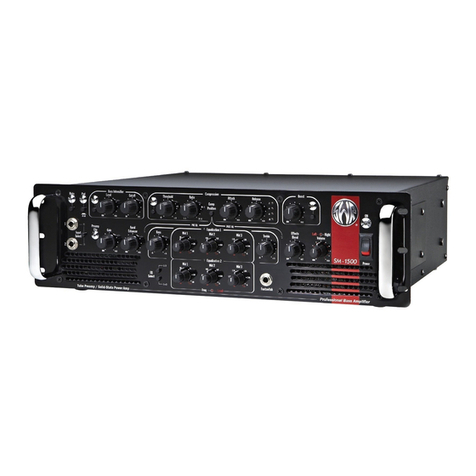
SWR
SWR SM-1500 User manual
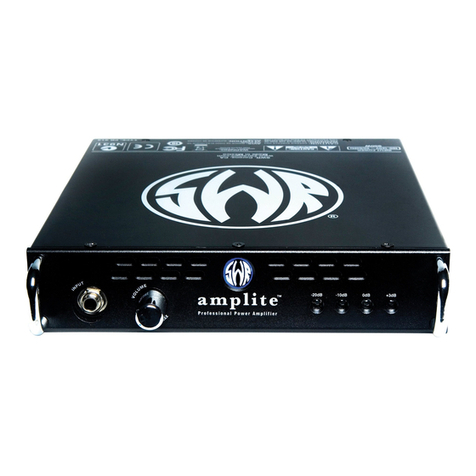
SWR
SWR amplite User manual
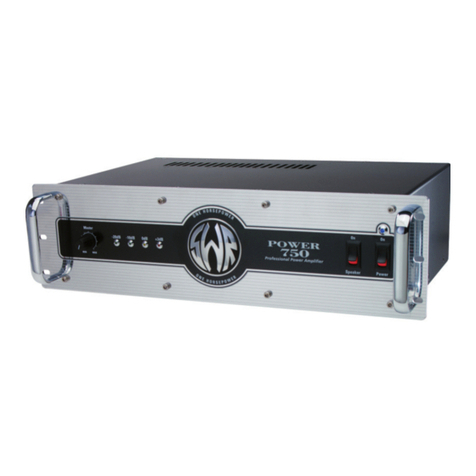
SWR
SWR Amplifier POWER 750 User manual
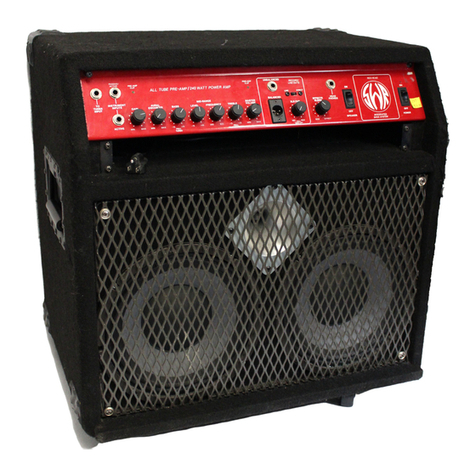
SWR
SWR Super Redhead User manual

SWR
SWR BASS 750 User manual
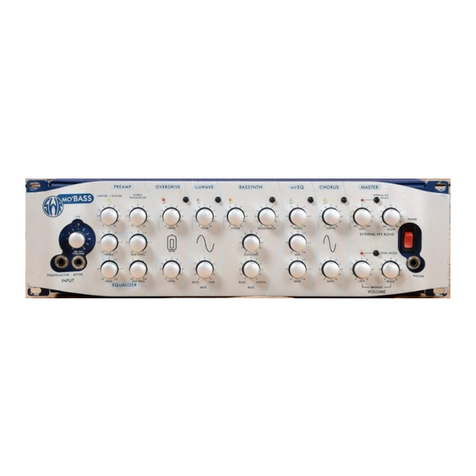
SWR
SWR Mo' Bass User manual
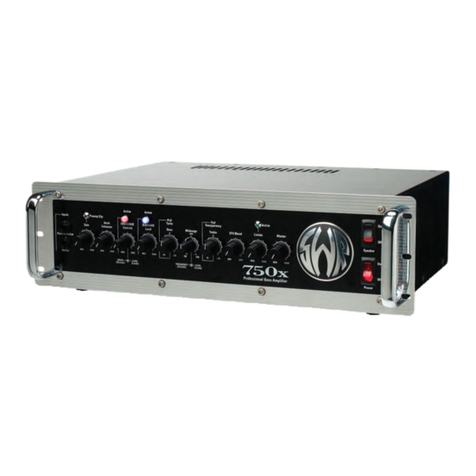
SWR
SWR 750x Bass Amplifier 750x User manual
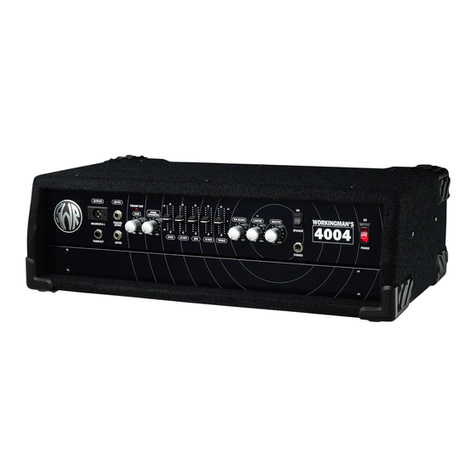
SWR
SWR WORKINGMAN'S 4004 User manual
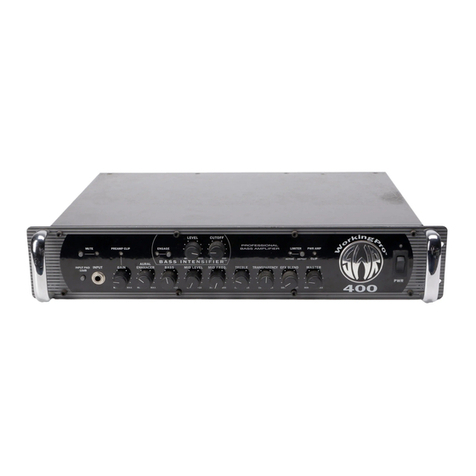
SWR
SWR WorkingPro Series User manual
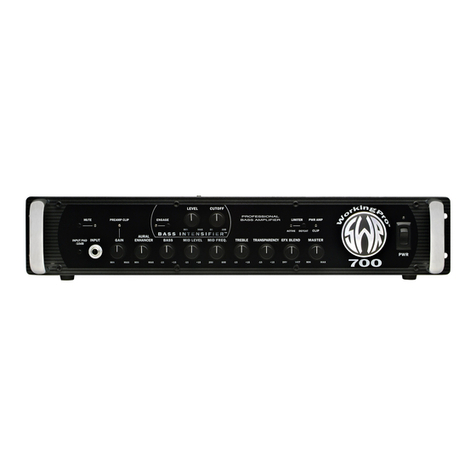
SWR
SWR WorkingPro WorkingPro 700 User manual
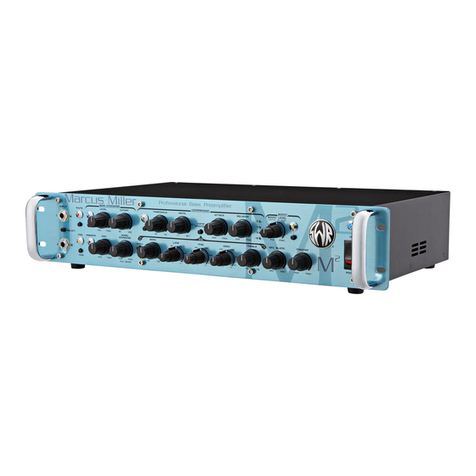
SWR
SWR Marcus Miller User manual
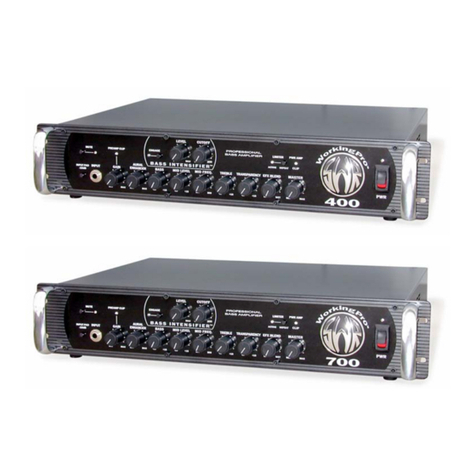
SWR
SWR WorkingPro 400 User manual
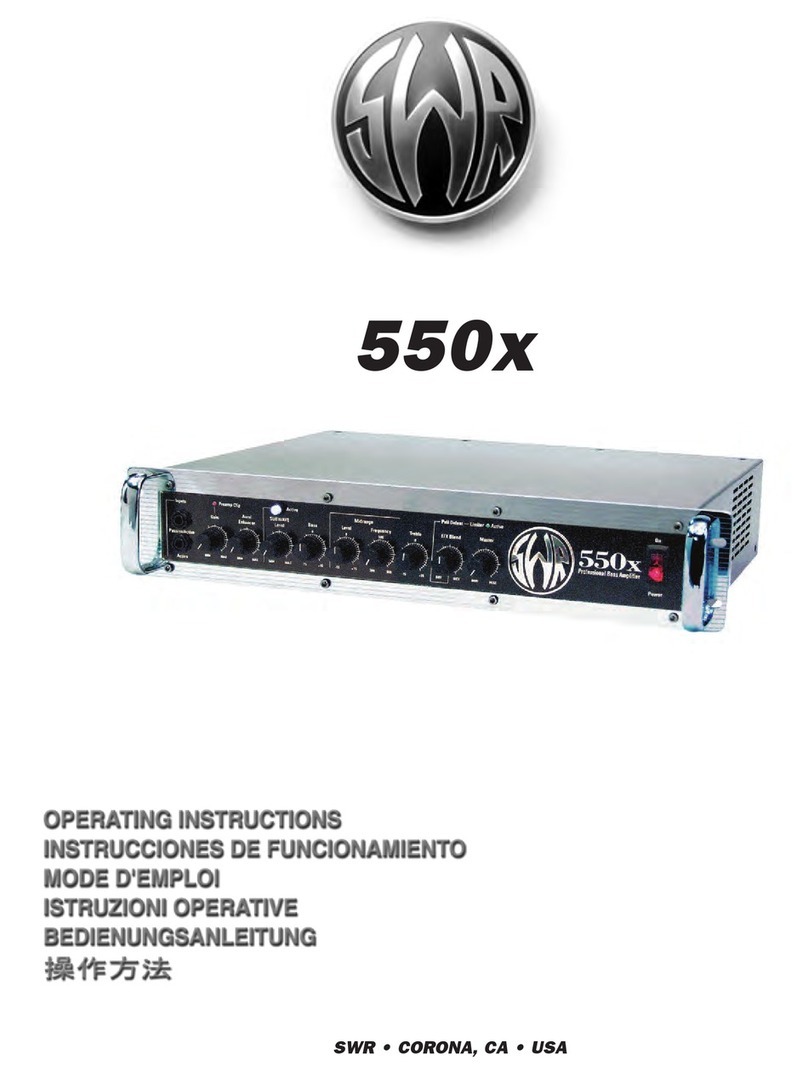
SWR
SWR 550x User manual
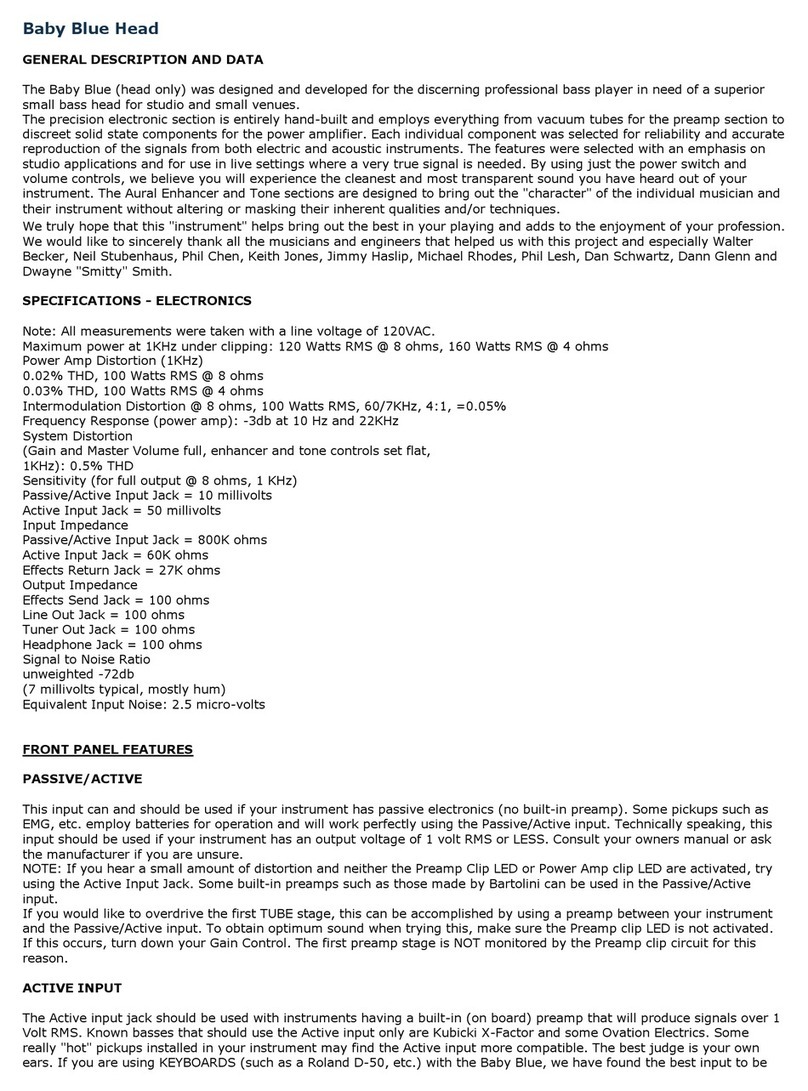
SWR
SWR Baby Blue Head User manual
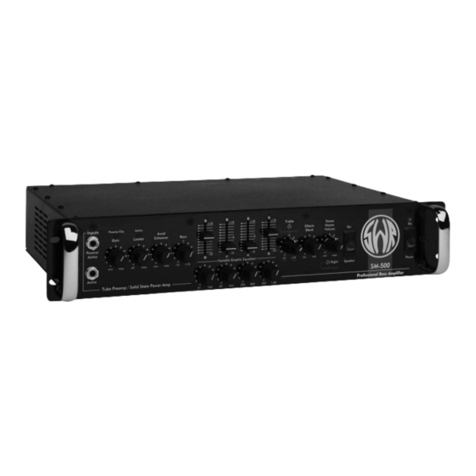
SWR
SWR SM-500 User manual
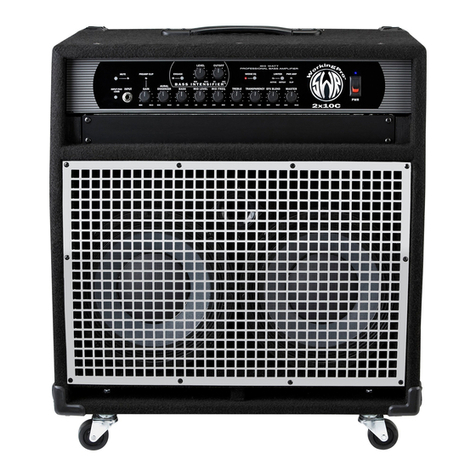
SWR
SWR WorkingPro 2x10C User manual
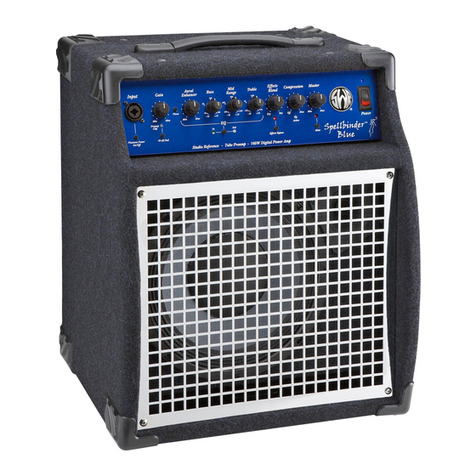
SWR
SWR Spellbinder Blue User manual
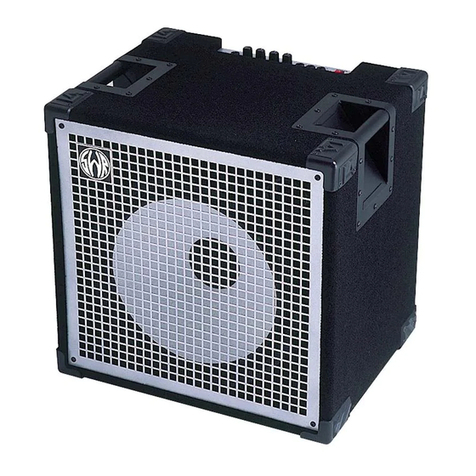
SWR
SWR LA 15 User manual
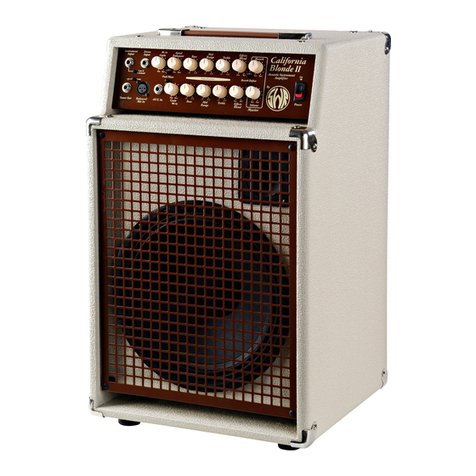
SWR
SWR California Blonde II User manual
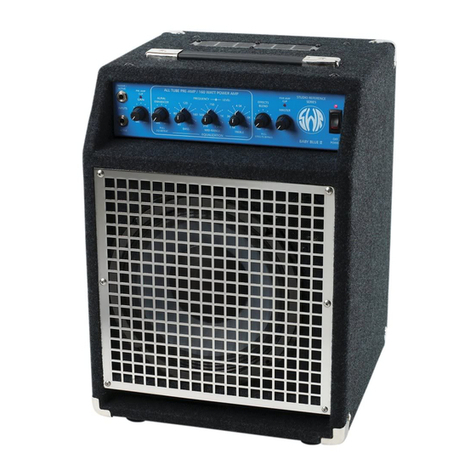
SWR
SWR Baby Baby Blue User manual



